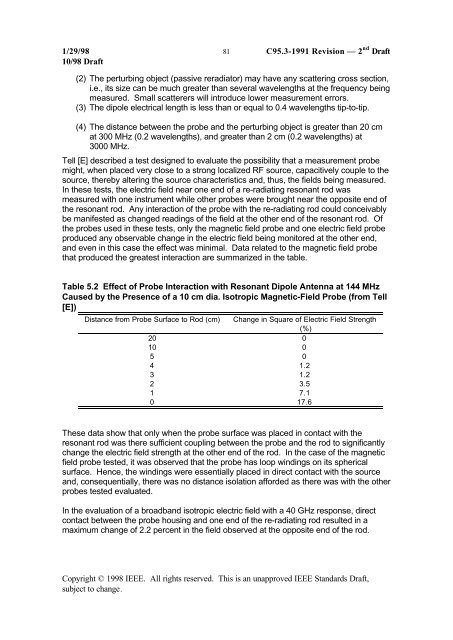DRAFT Recommended Practice for Measurements and ...
DRAFT Recommended Practice for Measurements and ...
DRAFT Recommended Practice for Measurements and ...
Create successful ePaper yourself
Turn your PDF publications into a flip-book with our unique Google optimized e-Paper software.
1/29/98 81 C95.3-1991 Revision — 2 nd Draft<br />
10/98 Draft<br />
(2) The perturbing object (passive reradiator) may have any scattering cross section,<br />
i.e., its size can be much greater than several wavelengths at the frequency being<br />
measured. Small scatterers will introduce lower measurement errors.<br />
(3) The dipole electrical length is less than or equal to 0.4 wavelengths tip-to-tip.<br />
(4) The distance between the probe <strong>and</strong> the perturbing object is greater than 20 cm<br />
at 300 MHz (0.2 wavelengths), <strong>and</strong> greater than 2 cm (0.2 wavelengths) at<br />
3000 MHz.<br />
Tell [E] described a test designed to evaluate the possibility that a measurement probe<br />
might, when placed very close to a strong localized RF source, capacitively couple to the<br />
source, thereby altering the source characteristics <strong>and</strong>, thus, the fields being measured.<br />
In these tests, the electric field near one end of a re-radiating resonant rod was<br />
measured with one instrument while other probes were brought near the opposite end of<br />
the resonant rod. Any interaction of the probe with the re-radiating rod could conceivably<br />
be manifested as changed readings of the field at the other end of the resonant rod. Of<br />
the probes used in these tests, only the magnetic field probe <strong>and</strong> one electric field probe<br />
produced any observable change in the electric field being monitored at the other end,<br />
<strong>and</strong> even in this case the effect was minimal. Data related to the magnetic field probe<br />
that produced the greatest interaction are summarized in the table.<br />
Table 5.2 Effect of Probe Interaction with Resonant Dipole Antenna at 144 MHz<br />
Caused by the Presence of a 10 cm dia. Isotropic Magnetic-Field Probe (from Tell<br />
[E])<br />
Distance from Probe Surface to Rod (cm) Change in Square of Electric Field Strength<br />
(%)<br />
20 0<br />
10 0<br />
5 0<br />
4 1.2<br />
3 1.2<br />
2 3.5<br />
1 7.1<br />
0 17.6<br />
These data show that only when the probe surface was placed in contact with the<br />
resonant rod was there sufficient coupling between the probe <strong>and</strong> the rod to significantly<br />
change the electric field strength at the other end of the rod. In the case of the magnetic<br />
field probe tested, it was observed that the probe has loop windings on its spherical<br />
surface. Hence, the windings were essentially placed in direct contact with the source<br />
<strong>and</strong>, consequentially, there was no distance isolation af<strong>for</strong>ded as there was with the other<br />
probes tested evaluated.<br />
In the evaluation of a broadb<strong>and</strong> isotropic electric field with a 40 GHz response, direct<br />
contact between the probe housing <strong>and</strong> one end of the re-radiating rod resulted in a<br />
maximum change of 2.2 percent in the field observed at the opposite end of the rod.<br />
Copyright © 1998 IEEE. All rights reserved. This is an unapproved IEEE St<strong>and</strong>ards Draft,<br />
subject to change.
















